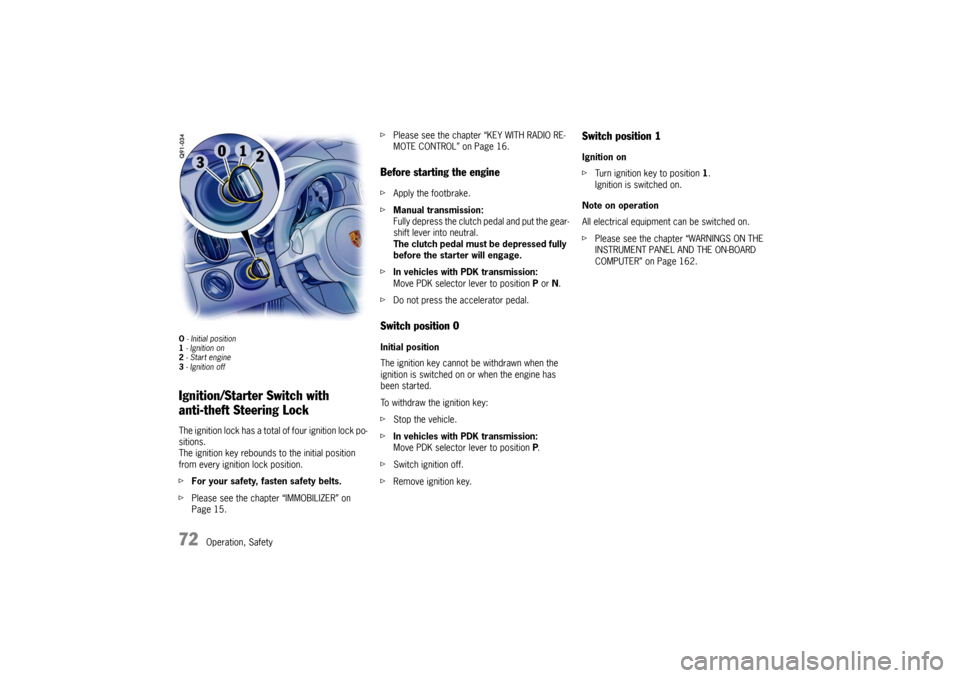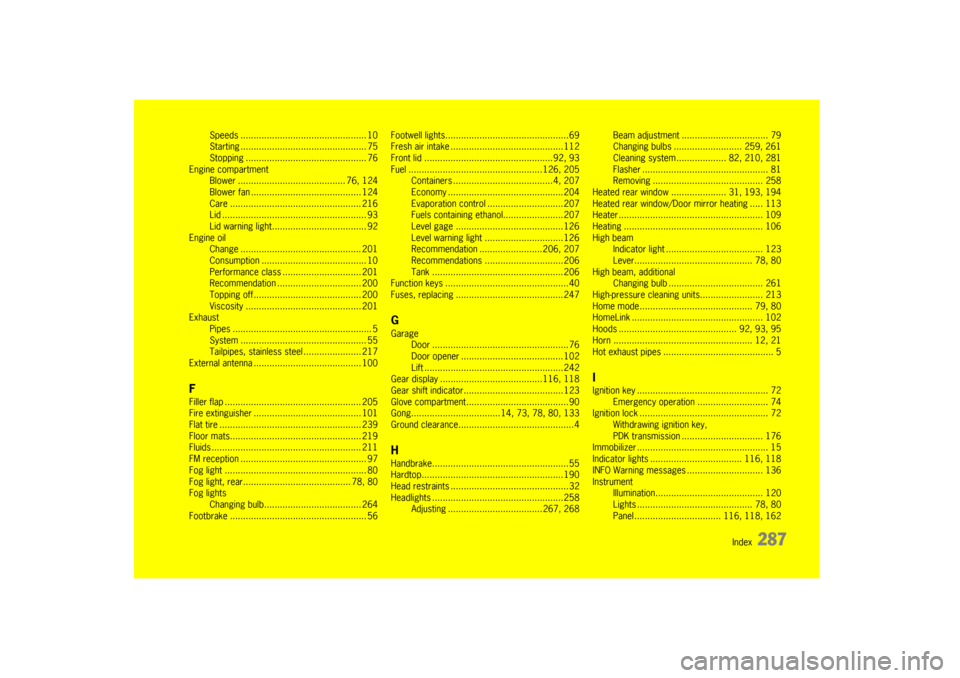immobilizer PORSCHE BOXSTER S 2010 2.G Owners Manual
[x] Cancel search | Manufacturer: PORSCHE, Model Year: 2010, Model line: BOXSTER S, Model: PORSCHE BOXSTER S 2010 2.GPages: 294, PDF Size: 6.89 MB
Page 17 of 294

Operation, Safety
15
Keys fPlease see the chapter “ALARM SYSTEM, PAS-
SENGER COMPARTMENT MONITORING” on
Page 25.
f Please see the chapter “CENTRAL LOCKING IN
CARS WITHOUT ALARM SYSTEM” on Page 19.
f Please see the chapter “CENTRAL LOCKING IN
CARS WITH ALARM SYSTEM” on Page 21.
Two car keys are supplied with your Porsche.
These keys operate all the locks on your vehicle.
f Be careful with your car keys: do not part with
them except under exceptional circumstances.
f To avoid battery run-down, always remove the
ignition key from the ignition lock. Emergency operationfPlease see the chapter “EMERGENCY OPERA-
TION – PULLING OUT THE IGNITION KEY” on
Page 74.
Replacement keys Replacement car keys can be obtained only from
your authorized Porsche dealer, and this can
sometimes be very time-consuming.
You should therefore always keep a spare key on
your person.
Keep it in a safe place (e.g. wallet), but under no
circumstances in or on the vehicle.
The key codes of new keys have to be “reported”
to the car control unit by your authorized Porsche
dealer.
A total of 6 car keys can be reported to the control
unit.
Disabling key codes
If a key is lost, the key codes can be disabled by
an authorized Porsche dealer.
All the remaining car keys are required for this pur-
pose.
Disabling the code ensures that the car can be
started only using authorized keys.
Note
f Please note that the other locks can still be
opened with the disabled key.
Immobilizer There is a transponder (an electronic component)
in the key grip, conta ining a stored code.
When the ignition is switch ed on, the ignition lock
checks the code.
The immobilizer can be deactivated and the en-
gine started only using an authorized ignition key.
Switching off the immobilizer
f Insert the ignition key into the ignition lock.
If the ignition is left on for more than 2 minutes
without the engine being started, the immobilizer
is switched on again.
f If this happens, turn the ignition key back to
position 3 (ignition off) before starting the
engine. The immobilizer is switched off again,
and the engine can be started.
f Please see the chapter “IGNITION/STARTER
SWITCH WITH ANTI-THEFT STEERING LOCK”
on Page 72.
Switching on the immobilizer
f Remove ignition key.Security Wheel Bolts fIf wheels have to be removed during a work-
shop visit, do not forget to hand over the sock-
et for the security wheel bolts along with the
car key.
Page 74 of 294

72
Operation, Safety
O - Initial position
1 - Ignition on
2 - Start engine
3 - Ignition offIgnition/Starter Switch with
anti-theft Steering LockThe ignition lock has a total of four ignition lock po-
sitions.
The ignition key rebounds to the initial position
from every ignition lock position.
f For your safety, fasten safety belts.
f Please see the chapter “IMMOBILIZER” on
Page 15. f
Please see the chapter “KEY WITH RADIO RE-
MOTE CONTROL” on Page 16.
Before starting the enginefApply the footbrake.
f Manual transmission:
Fully depress the clutch pedal and put the gear-
shift lever into neutral.
The clutch pedal must be depressed fully
before the starte r will engage.
f In vehicles with PDK transmission:
Move PDK selector lever to position P or N.
f Do not press the accelerator pedal.Switch position 0 Initial position
The ignition key cannot be withdrawn when the
ignition is switched on or when the engine has
been started.
To withdraw the ignition key:
f Stop the vehicle.
f In vehicles with PDK transmission:
Move PDK selector lever to position P.
f Switch ignition off.
f Remove ignition key.
Switch position 1 Ignition on
fTurn ignition key to position 1.
Ignition is switched on.
Note on operation
All electrical equipme nt can be switched on.
f Please see the chapter “WARNINGS ON THE
INSTRUMENT PANEL AND THE ON-BOARD
COMPUTER” on Page 162.
Page 77 of 294

Operation, Safety
75
Starting Procedures fPlease see the chapter “IMMOBILIZER” on
Page 15.
f Please see the chapter “EMISSION CONTROL
SYSTEM” on Page 208.
Warning!
Serious injury or death may result if you are
involved in a collision without having fas-
tened the safety belts.
f Fasten safety belts before driving away. Before starting the engine fApply the footbrake.
f Manual transmission:
Fully depress the clutch pedal and put the gear-
shift lever into neutral.
The clutch pedal must be depressed fully
before the starter will engage.
f In vehicles with PDK transmission:
Move PDK selector lever to position P or N.
Temperature sensors on the engine automatically
provide the correct fuel/air mixture required for
starting.
Therefore, it is not necessary to depress the
accelerator pedal while starting a cold or a
warm engine.
Starting the enginef Turn ignition key to ignition lock position 2.
f As soon as the engine st arts, release the igni-
tion key.
The first operation of the starter is ended automat-
ically when the engine starts.
If the engine does not start, subsequent starter
operations will not be ended automatically.
If the engine fails to start after 10 or 15 seconds
of cranking:
f Wait about 10 seconds before engaging the
starter again.
f When starting the engine, be ready to drive
immediately.
Drive vehicle at moderate speeds and avoid
engine speeds above 4,200 rpm during the
first 5 minutes.
f Do not let the engine idle to warm up.
Danger!
Engine exhaust fumes have many compo-
nents which you can smell. They also contain
carbon monoxide (CO), which is a colorless
and odorless gas.
Carbon monoxide can cause unconscious-
ness and even death if inhaled.
f Never start or let the engine run in an
enclosed, unventilated area.
It is not recommended to sit in your car for prolonged periods with the engine on and the
car not moving.
An unattended vehicle with a running engine
is potentially hazardous.
If warning lights shoul d come on to indicate
improper operation, they would go unno-
ticed.
f Never leave the engine idling unattended.
Danger of fire.
f Do not park or operate the vehicle in areas
where the hot exhaust system may come in
contact with dry grass, brush, fuel spill or oth-
er flammable material.
f If your car catches on fire for any reason, call
the fire department.
Do not endanger your life by attempting to put
out the fire.
Risk of burn injury when standing near or coming
into contact with the exhaust pipe.
The exhaust pipe is hot when the vehicle is running
and remains hot for some time after the vehicle is
turned off.
f To prevent injury, make a point of noting where
your vehicle’s exhaust pipe is, avoid placing
your legs near the exhaust pipe, and closely
supervise children around the vehicle when the
exhaust pipe could be hot.
A hot exhaust pipe can cause serious burns.
Page 289 of 294

Index
287
Speeds ................................................ 10
Starting .................. .............................. 75
Stopping .............................................. 76
Engine compartment Blower ....................... .................. 76, 124
Blower fan .............. ............................ 124
Care .................................................. 216
Lid ....................................................... 93
Lid warning light...... .............................. 92
Engine oil Change .............................................. 201
Consumption ............................... ......... 10
Performance class .. ............................ 201
Recommendation ........ ........................ 200
Topping off............. ............................ 200
Viscosity ................ ............................ 201
Exhaust
Pipes ......................... ............................ 5
System ................................................ 55
Tailpipes, stainless st eel ...................... 217
External antenna ......... ................................ 100
FFiller flap .................................................... 205
Fire extinguisher ......................................... 101
Flat tire ...................... ................................ 239
Floor mats.................. ................................ 219
Fluids ......................................................... 211
FM reception ................................... ............. 97
Fog light ............................................. ......... 80
Fog light, rear................. ........................ 78, 80
Fog lights Changing bulb......... ............................ 264
Footbrake ........................................... ......... 56Footwell lights...........
....................................69
Fresh air intake ......... ..................................112
Front lid ....................... ..........................92, 93
Fuel ..................... ..............................126, 205
Containers ................ ......................4, 207
Economy .................. ..........................204
Evaporation control .............................207
Fuels containing etha nol.......................207
Level gage ............... ..........................126
Level warning light ..............................126
Recommendation ........................206, 207
Recommendations .... ..........................206
Tank ..................................................206
Function keys ........... ....................................40
Fuses, replacing ....... ..................................247
GGarage
Door ....................................................76
Door opener .......................................102
Lift ............... ......................... .............242
Gear display ................. ......................116, 118
Gear shift indicator ......................................123
Glove compartment... ....................................90
Gong.................... ..............14, 73, 78, 80, 133
Ground clearance...... ......................................4HHandbrake.................... ................................55
Hardtop........................ ..............................190
Head restraints ......... ....................................32
Headlights .................... ..............................258
Adjusting .................. ..................267, 268 Beam adjustment .
................................ 79
Changing bulbs .......................... 259, 261
Cleaning system ....... ............ 82, 210, 281
Flasher ................................................ 81
Removing ................ .......................... 258
Heated rear window ..... ................ 31, 193, 194
Heated rear window/Door mirror heating ..... 113
Heater ......................... .............................. 109
Heating ........................................... .......... 106
High beam Indicator light ....... .............................. 123
Lever....................... ...................... 78, 80
High beam, additional Changing bulb ...... .............................. 261
High-pressure cleaning units........................ 213
Home mode..................... ...................... 79, 80
HomeLink .................... .............................. 102
Hoods ............................. ................ 92, 93, 95
Horn ........................................... .......... 12, 21
Hot exhaust pipes ... ....................................... 5
IIgnition key ............. ..................................... 72
Emergency operation ........................... 74
Ignition lock ............ ..................................... 72
Withdrawing ignition key,
PDK transmission ..................... .......... 176
Immobilizer ...................................... ............ 15
Indicator lights ................. .................. 116, 118
INFO Warning message s ............................. 136
Instrument Illumination........... .............................. 120
Lights ...................... ...................... 78, 80
Panel ........................... ...... 116, 118, 162